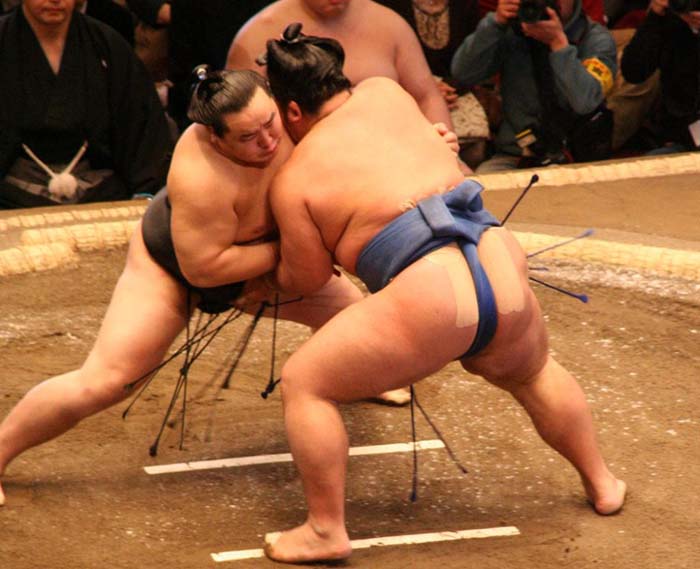

Sumo is a competitive full-contact sport where a wrestler (rikishi) attempts to force another wrestler out of a circular ring (dohyo) or to touch the ground with anything other than the soles of the feet. The sport originated in Japan, the only country where it is practiced professionally. It is generally considered to be a gendai budo (a modern Japanese martial art), though this definition is incorrect as the sport has a history spanning many centuries. Many ancient traditions have been preserved in sumo, and even today the sport includes many ritual elements, such as the use of salt purification, from the days when sumo was used in the Shinto religion.
Life as a rikishi is highly regimented, with rules laid down by the Sumo Association. Most sumo wrestlers are required to live in communal "sumo training stables" known in Japanese as heya where all aspects of their daily lives from meals to their manner of dress - are dictated by strict tradition.
Over the rest of Japanese recorded history, sumo's popularity has changed according to the whims of its rulers and the need for its use as a training tool in periods of civil strife. The form of wrestling combat probably changed gradually into one where the main aim in victory was to throw one's opponent. The concept of pushing one's opponent out of a defined area came some time later.
Also, it is believed that a ring, defined as something other than simply the area given to the wrestlers by spectators, came into being in the 16th century as a result of a tournament organized by the then principal warlord in Japan, Oda Nobunaga. At this point wrestlers would wear loose loincloths, rather than the much stiffer mawashi of today. During the Edo period, wrestlers would wear a fringed kesho-mawashi during the bout, whereas today these are worn only during pre-tournament rituals. Most of the rest of the current forms within the sport developed in the early Edo period.
Professional sumo can trace its roots back to the Edo period in Japan as a form of sporting entertainment. The original wrestlers were probably samurai, often ronin who needed to find an alternative form of income. Current professional sumo tournaments began in the Tomioka Hachiman Shrine in 1684, and then were held in the Eko-in in the Edo period. They have been held in the Ryogoku Kokugikan since 1909, though the Kuramae Kokugikan had been used for the tournaments in the post-war years until 1984. Nations adjacent to Japan, sharing many cultural traditions, also feature styles of traditional wrestling that bear resemblance to sumo. Notable examples include Mongolian wrestling, Chinese Shuai jiao and Korean Ssireum. Examples of Chinese art from 220 BC show the Korean wrestlers stripped to the waist and their bodies pressed shoulder to shoulder. Sumo Wrestling